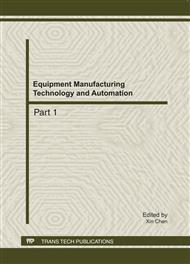[1]
H. H. Loh and M. S. Lu, "Printed circuit board inspection using image analysis". IEEE Transactions on Industry Applications, vol 35, no.2, 1999 , pp.426-432.
DOI: 10.1109/28.753638
Google Scholar
[2]
T. ZedniceK, P. Vasina, Z. Sita, B.Vrana. "Lead-free soldering effect to tantalum capacitors", 26th International Spring Seminar on Electronics Technology, Slovak Republic, 8-10 May.2003, pp.85-89.
DOI: 10.1109/isse.2003.1260489
Google Scholar
[3]
J. Nguyen, D. Geiger, D. Rooney, D. Shangguan. "Solder Joint Characteristics and Reliability of Lead-Free Area Array Packages Assembled Under Various Tin-Lead Soldering Process Conditions", 2007 Electronic Components and Technology Conference, 2007, pp.1340-1349.
DOI: 10.1109/ectc.2007.373969
Google Scholar
[4]
D. W. Raymond, D. F. Haigh, "Why automate optical inspection". International Test Conference, 1997, p.1033.
DOI: 10.1109/test.1997.639723
Google Scholar
[5]
Chang-bing Bai, Chun Qi. "Fast detection of circular pcb mark using Hough transform", Opto-electronic Engineering",vol32,no9,2005, pp.75-78.
Google Scholar
[6]
Cheng-peng Li, Yan-bin Fan. "3 recognition methods and analysis of PCB Mark point based on HALCON",Journal of Foshan University(Natural Science Edition),vol28,no2,2010, pp.29-33.
Google Scholar
[7]
Gao-fei OUYANG, Yong-cong Kuang. "Accurate Image Capture for Surface Mounting Component Based on Subpixel Location" Opto-electronic engineering,vol37,no6,2010, pp.16-22.
Google Scholar
[8]
Shenglin Lu, Xianmin Zhang. "An Integrated Inspection Method based on Machine Vision for Solder Paste Depositing". IEEE International Conference on Control and Automation,Guangzhou, CHINA , May 30 to June 1,2007,pp.137-141.
DOI: 10.1109/icca.2007.4376334
Google Scholar
[9]
D.W. Capson, S.K. Eng, "A tiered-color illumination approach for machine inspection of solder joints", IEEE transactions on pattern analysis and machine intelligence, vol10, no3, 1988),pp.387-393.
DOI: 10.1109/34.3902
Google Scholar
[10]
N. Otsu, "A threshold selection method from graylevel histograms", IEEE transactions on systrems, man, and cybernetics, volSMC-9,no1, 1979 ,pp.62-66.
DOI: 10.1109/tsmc.1979.4310076
Google Scholar
[11]
Fupei Wu, XianminZhang, "Robust positioning algorithm of lead-free solder joints based on gray-level integration projection", Journal of South China University of Technology, vol37,no9,2009,pp.98-102.
Google Scholar
[12]
Carsten Steger,Makus Urich: machine vision algorithms and applications( Tsinghua university press.China2009)
Google Scholar
[13]
Fupei Wu, Xianmin Zhang, "An AOI algorithm for transistor lead-free solder joints of SMT post-reflow",transactions of the china welding institution ,vol30,no7,2009.pp.5-8
Google Scholar


